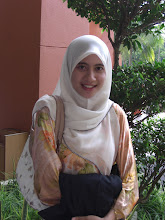Kami diminta oleh Hjh Halimah untuk menulis perkara-perkara berikut:
- Nama penuh
- Program sekarang
- Status diri
- Alamat rumah
- Program yang diambil semasa Ijazah Sarjana Muda
- Universiti semasa mengambil Ijazah Sarjana Muda
- Nama guru yang menjadi idola
- Kenapa guru tersebut menjadi idola
- Nama guru yang tidak disukai
- Kenapa guru tersebut tidak disukai
- Kenapa ingin menjadi seorang guru
- Apa peranan sebenar seorang guru
- Lukis gambar sebatang pokok beserta tandatangan dan tarikh lahir
Kerja berpasangan :
1. memilih satu tajuk kertas kerja yang dibentangkan di Seminar Serantau UKM-UNRI, Klana Resort, Seremban.
2. tulis isi-isi penting yang telah dicatat semasa pembentangan kertas kerja tersebut.
3. pembentangan di hadapan kelas.
Ahli kumpulan:
1. Najwa Hayatee bt Abdullah
2. Nur Faizah bt Azizan
Tajuk:
Meningkatkan Kemampuan Menulis Mahasiswa Program Studi Bahasa Inggeris FKIP UNRI melalui Pembelajaran Koperatif STAD.
Pembentang:
Novitri
Tempat:
Bilik Seri Menanti, Klana Resort, Seremban.
Sesi:
Selari 4C (2pm-4pm)
1. bentuk kumpulan dengan 5 orang ahli. setiap kumpulan harus mempunyai ahli yang berbeza jantina, bangsa dan pengkhususan).
2. bincang dan pilih tajuk untuk sebuah kertas cadangan kajian tindakan.
3. proposal mesti dihantar pada 28 Mei 2009.
Ahli Kumpulan:
1. Najwa Hayatee bt Abdullah (Bio)
2. Nur Faizah bt Azizan (Bio)
3. Halina bt Yusof (PI)
4. Norbasirah bt Saodi (PI)
5. Nor Afsah bt Mohd Nor (PI)
Tajuk Proposal :
Meningkatkan Penghafalan dan Penguasaan Dhomir Bahasa Arab Menggunakan Teknik Berlagu dikalangan Murid Tahun 2 (j-Qaf)

